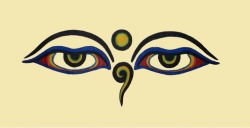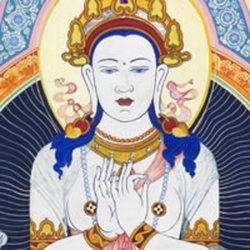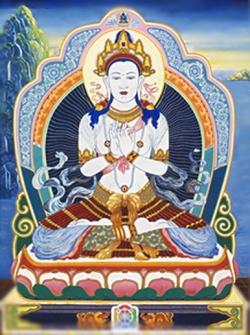Difference between revisions of "Buddha lochana"
m (1 revision: Adminos 2 november) |
|||
| (4 intermediate revisions by the same user not shown) | |||
| Line 1: | Line 1: | ||
[[File:BodhnathEyes.jpg|thumb|250px|]] | [[File:BodhnathEyes.jpg|thumb|250px|]] | ||
| + | |||
| + | |||
| + | |||
| + | |||
| + | |||
| + | |||
| + | |||
| + | |||
<poem> | <poem> | ||
[[File:Ochana_det01.jpg|thumb|250px|]] | [[File:Ochana_det01.jpg|thumb|250px|]] | ||
| − | [[Buddha lochana]] (Skt. [[Buddhalocanā]]; Tib. {{BigTibetan|[[སངས་རྒྱས་སྤྱན་]]}}, [[Sangyé Chenma]]; Wyl. [[sangs rgyas spyan ma]]) — Buddha-Lochana - the [[Buddha eye]]; [[consort]] of {{BigTibetan|[[རིན་ཆེན་འབྱུང་གནས]]}}{{BigTibetan|་}} ; [[buddhalocana]] ([[yum | + | [[Buddha lochana]] (Skt. [[Buddhalocanā]]; Tib. {{BigTibetan|[[སངས་རྒྱས་སྤྱན་]]}}, [[Sangyé Chenma]]; [[Wyl.]] [[sangs rgyas spyan ma]]) — [[Buddha]]-[[Lochana]] - the [[Buddha eye]]; [[consort]] of {{BigTibetan|[[རིན་ཆེན་འབྱུང་གནས]]}}{{BigTibetan|་}} ; [[buddhalocana]] ([[yum is mi bskyod pa]]; [[locana]], [[yab]] is [[rnam par snang mdzad]]) one of the [[five female buddhas]] and the [[consort of Akshobhya]]. |
| + | |||
| + | In the [[Panchakara]] of [[Advayavajra Samgraha Lochana]] is said to be originated from the [[seed syllable]] [[Lom]], white in complexion. | ||
| + | |||
| + | [[Lochana]] belongs to [[Tathagata kula]]. Her [[recognition]] [[symbol]] is a [[wheel]]. [[Lochana]] is said to be [[Prajna of Vairochana]]. | ||
| + | |||
| + | [[Lochana]] is said to be similar in {{Wiki|nature}} as [[Lord]] [[Vairochana]]. | ||
| + | |||
| + | [[Lochana]] is seated in [[Lalita Asana]] and displays [[Varadamudra]] with her right hand. Her left palm is on the {{Wiki|chest}}. From both the palms rise the stalks of [[lotus]], supporting a [[Vajra]]. | ||
[[File:Ochana_298.jpg|thumb|250px|]] | [[File:Ochana_298.jpg|thumb|250px|]] | ||
| − | |||
| − | The special [[characteristic]] of this [[deity]] is that those {{Wiki|devotees}} engrossed in [[delusion]] acquire all pervasive | + | In [[Hevajra Tantra]] and its commentary it is said that [[Lochana]], [[Mamaki]], [[Pandara]] and [[Tara]] represent the [[four elements]] i.e. [[earth]], [[water]], [[fire]] and [[air]]. |
| + | |||
| + | [[Lochana]] has many [[forms]], some [[peaceful]] and some [[wrathful]]. | ||
| + | |||
| + | [[Lochana]] can be found in two armed, six armed and eight armed as described in various [[Mandalas]]. Her images are very rare. A magnificent {{Wiki|image}} of [[Lochana]] can be found in the [[Swayambhu Stupa]]. | ||
| + | |||
| + | In the [[Guru]] [[mandala]] [[rite]] of {{Wiki|Nepalese}} [[Buddhists]] [[Vajracharyas]] make [[offerings]] to the five [[Buddhas]] and their [[Prajnas]]. | ||
| + | |||
| + | The special [[characteristic]] of this [[deity]] is that those {{Wiki|devotees}} engrossed in [[delusion]] acquire [[all pervasive wisdom]] through the [[Sadhana]] of [[Buddha]] [[Vairochana]] and [[Lochana]]. | ||
| + | |||
| + | It is said that the [[essence]] of [[delusion]] is also [[Dharmakaya]] which is free from [[thought]] constructs. So through the practice, [[delusion]] is transmuted into [[wisdom of all pervasive awareness]]. ([[Sanskrit]]: [[Suvisuddha Dharmadhatu Janana]]). | ||
| + | |||
[[Kegon]] [[Buddhism]] ([[Japan]]) {{Wiki|preached}} that the state—the government—was the [[physical]] [[manifestation]] of the [[Buddha Lochana’s]] [[universal]], {{Wiki|interrelated}} [[order]]. | [[Kegon]] [[Buddhism]] ([[Japan]]) {{Wiki|preached}} that the state—the government—was the [[physical]] [[manifestation]] of the [[Buddha Lochana’s]] [[universal]], {{Wiki|interrelated}} [[order]]. | ||
| − | |||
| − | The [[Earth element]] is [[Buddha]] [[Lochana]]. A | + | [[Yeshe Tsogyal]] was a [[dakini]] and [[emanation of the female Buddha Lochana]]. |
| + | |||
| + | [[Lochana Buddha]], complete [[Sambhogakaya]] - [[Lochana]], full and complete [[Sambogakaya Buddha]]; [[consort Lochana]] who expresses the [[mirror-like primordial wisdom]]' | ||
| + | |||
| + | |||
| + | The [[Earth element]] is [[Buddha]] [[Lochana]]. A [[female Buddha]] represents the [[purity]] of the [[element]] [[earth]]. | ||
| + | |||
| + | [[Lochana]] A {{Wiki|female}} [[Buddha]] who is the [[manifestation]] of the [[earth element]] of all [[Buddhas]]. | ||
| + | |||
The [[Water element]] is [[Mamaki]]; | The [[Water element]] is [[Mamaki]]; | ||
The [[Fire element]] is [[Pundarika]]; | The [[Fire element]] is [[Pundarika]]; | ||
| Line 18: | Line 51: | ||
| − | [[Buddha | + | [[Buddha Lochana]]) [[Attachment]] to [[form]] leads to the [[affliction]] of [[anger]] ([[aggression]]). |
| − | + | ||
| + | the [[Five Buddhas]] | ||
| + | |||
| + | ([[Mamaki]], | ||
| + | [[Lochana]], | ||
| + | [[Vajradhatvishvari]], | ||
| + | [[Pandara]] and | ||
| + | [[Tara]]) the {{Wiki|unity}} of their qualities and [[attributes]]. [[Lochana]] is [[representing the monkhood]]. | ||
| + | |||
| + | |||
| + | [[Sun Buddha]] in which [[Lochana]] was a [[form]] of [[messengers]] had to be sent to [[Ise]] to gain the approval of the [[Sun Goddess]] {{Wiki|Amaterasu}} of [[Shinto]] for the erection of the {{Wiki|Sun}} [[Buddha]] statue. | ||
| − | + | [[Animesha Lochana Chaitya]] Situated on the {{Wiki|north}} {{Wiki|east}} of the [[Mahabodhi Temple]], this is the place where the [[Buddha]] spent the second [[week]] in [[meditation]] in [[standing]] [[posture]] gazing at the [[Bodhi Tree]] with motionless [[eyes]] for one whole [[week]]. | |
| − | [[Vajrapani]] has a towfold role. In the [[Hinayana]] texts he is an {{Wiki|attendant}} of [[Gautama Buddha]] while in the [[Mahayana]] {{Wiki|iconography}} he is a [[Dhyani | + | [[Vajrapani]] has a towfold role. In the [[Hinayana]] texts he is an {{Wiki|attendant}} of [[Gautama Buddha]] while in the [[Mahayana]] {{Wiki|iconography}} he is a [[Dhyani Bodhisattva]] and an [[emanation of Akshobhya]] and [[Vajrapani's Sakti]] is [[Lochana]]. |
[[Buddha eye]] | [[Buddha eye]] | ||
[[仏眼]] ( Jpn [[butsu-gen]] ) | [[仏眼]] ( Jpn [[butsu-gen]] ) | ||
| − | The [[supreme]] perceptive faculty possessed by a [[Buddha]]. One of the five types of [[vision]]. A [[Buddha]] is said to {{Wiki|perceive}} the [[true nature]] of all things and [[phenomena]], transcending limitations of [[time]] and [[space]]. The [[Nirvana Sutra]] says, "Those who study the teachings of the [[great vehicle]], though they have the [[eyes]] of ordinary [[beings]], are said to have the [[eyes]] of the [[Buddha]]." | + | The [[supreme]] perceptive {{Wiki|faculty}} possessed by a [[Buddha]]. One of the five types of [[vision]]. A [[Buddha]] is said to {{Wiki|perceive}} the [[true nature]] of all things and [[phenomena]], transcending limitations of [[time]] and [[space]]. The [[Nirvana Sutra]] says, "Those who study the teachings of the [[great vehicle]], though they have the [[eyes]] of ordinary [[beings]], are said to have the [[eyes]] of the [[Buddha]]." |
| + | |||
[[Buddha Eye]] | [[Buddha Eye]] | ||
[[仏眼]] (Skt [[Buddhalochana]]; Jpn [[Butsugen]]) | [[仏眼]] (Skt [[Buddhalochana]]; Jpn [[Butsugen]]) | ||
| − | Also known as the Honored One [[Buddha Eye]] or [[Buddha Eye]] [[Buddha]] | + | Also known as the [[Honored One]] [[Buddha Eye]] or [[Buddha Eye]] ; [[Buddha Mother]]. A [[Buddha]] described in [[Esoteric Buddhism]] and believed to be [[Mahavairochana]] [[Buddha]] in a different [[form]]. |
| + | |||
| + | [[Buddha Eye]] is a [[personification]] of the [[Buddha's supreme wisdom]], viewed as the source or "[[mother of all Buddhas]] and [[bodhisattva]]s; hence the [[name]] [[Buddha Eye]] - [[Buddha]] Mother. | ||
| + | |||
| + | [[Buddha Eye]] appears on the [[Womb Realm mandala]], a [[mandala]] of the [[True Word]] ( Jpn [[Shingon]]) school. The {{Wiki|ceremony}} of [[Buddha Eye]], an [[esoteric ritual]], employed a [[mandala]] with [[Buddha Eye]] seated in the center as an [[object]] of [[devotion]], to which [[prayers]] were [[offered]] to bring an end to {{Wiki|calamities}} and misfortune. | ||
</poem> | </poem> | ||
{{R}} | {{R}} | ||
[http://www.sgilibrary.org/search_dict.php www.sgilibrary.org] | [http://www.sgilibrary.org/search_dict.php www.sgilibrary.org] | ||
[[Category:Buddhalochana]] | [[Category:Buddhalochana]] | ||
| − | + | [[Category:Lochana]] | |
| − | [[Category: | + | [[Category:Buddhist Terms]] |
Latest revision as of 15:49, 3 July 2024
Buddha lochana (Skt. Buddhalocanā; Tib. སངས་རྒྱས་སྤྱན་, Sangyé Chenma; Wyl. sangs rgyas spyan ma) — Buddha-Lochana - the Buddha eye; consort of རིན་ཆེན་འབྱུང་གནས་ ; buddhalocana (yum is mi bskyod pa; locana, yab is rnam par snang mdzad) one of the five female buddhas and the consort of Akshobhya.
In the Panchakara of Advayavajra Samgraha Lochana is said to be originated from the seed syllable Lom, white in complexion.
Lochana belongs to Tathagata kula. Her recognition symbol is a wheel. Lochana is said to be Prajna of Vairochana.
Lochana is said to be similar in nature as Lord Vairochana.
Lochana is seated in Lalita Asana and displays Varadamudra with her right hand. Her left palm is on the chest. From both the palms rise the stalks of lotus, supporting a Vajra.
In Hevajra Tantra and its commentary it is said that Lochana, Mamaki, Pandara and Tara represent the four elements i.e. earth, water, fire and air.
Lochana has many forms, some peaceful and some wrathful.
Lochana can be found in two armed, six armed and eight armed as described in various Mandalas. Her images are very rare. A magnificent image of Lochana can be found in the Swayambhu Stupa.
In the Guru mandala rite of Nepalese Buddhists Vajracharyas make offerings to the five Buddhas and their Prajnas.
The special characteristic of this deity is that those devotees engrossed in delusion acquire all pervasive wisdom through the Sadhana of Buddha Vairochana and Lochana.
It is said that the essence of delusion is also Dharmakaya which is free from thought constructs. So through the practice, delusion is transmuted into wisdom of all pervasive awareness. (Sanskrit: Suvisuddha Dharmadhatu Janana).
Kegon Buddhism (Japan) preached that the state—the government—was the physical manifestation of the Buddha Lochana’s universal, interrelated order.
Yeshe Tsogyal was a dakini and emanation of the female Buddha Lochana.
Lochana Buddha, complete Sambhogakaya - Lochana, full and complete Sambogakaya Buddha; consort Lochana who expresses the mirror-like primordial wisdom'
The Earth element is Buddha Lochana. A female Buddha represents the purity of the element earth.
Lochana A female Buddha who is the manifestation of the earth element of all Buddhas.
The Water element is Mamaki;
The Fire element is Pundarika;
The Wind element is Tara.
Buddha Lochana) Attachment to form leads to the affliction of anger (aggression).
the Five Buddhas
(Mamaki,
Lochana,
Vajradhatvishvari,
Pandara and
Tara) the unity of their qualities and attributes. Lochana is representing the monkhood.
Sun Buddha in which Lochana was a form of messengers had to be sent to Ise to gain the approval of the Sun Goddess Amaterasu of Shinto for the erection of the Sun Buddha statue.
Animesha Lochana Chaitya Situated on the north east of the Mahabodhi Temple, this is the place where the Buddha spent the second week in meditation in standing posture gazing at the Bodhi Tree with motionless eyes for one whole week.
Vajrapani has a towfold role. In the Hinayana texts he is an attendant of Gautama Buddha while in the Mahayana iconography he is a Dhyani Bodhisattva and an emanation of Akshobhya and Vajrapani's Sakti is Lochana.
Buddha eye
仏眼 ( Jpn butsu-gen )
The supreme perceptive faculty possessed by a Buddha. One of the five types of vision. A Buddha is said to perceive the true nature of all things and phenomena, transcending limitations of time and space. The Nirvana Sutra says, "Those who study the teachings of the great vehicle, though they have the eyes of ordinary beings, are said to have the eyes of the Buddha."
Buddha Eye
仏眼 (Skt Buddhalochana; Jpn Butsugen)
Also known as the Honored One Buddha Eye or Buddha Eye ; Buddha Mother. A Buddha described in Esoteric Buddhism and believed to be Mahavairochana Buddha in a different form.
Buddha Eye is a personification of the Buddha's supreme wisdom, viewed as the source or "mother of all Buddhas and bodhisattvas; hence the name Buddha Eye - Buddha Mother.
Buddha Eye appears on the Womb Realm mandala, a mandala of the True Word ( Jpn Shingon) school. The ceremony of Buddha Eye, an esoteric ritual, employed a mandala with Buddha Eye seated in the center as an object of devotion, to which prayers were offered to bring an end to calamities and misfortune.


